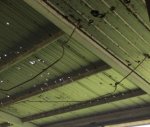ptonsparky
Tom
- Occupation
- EC - retired
They were using one of these the last time I was there.I'm told it's affects the devices trying to read the cows ear tags. The VFD and output wiring are basically like a giant FM antenna that cause interference issues. The closer the VFD and shorter the motor leads, the less interference.
Over here, they read the ear tags on the milking carousels for individual cow statistics, they also use the tags to automatically open and close sort gates to sort cows into certain pens, they are used for body condition cameras, and on and on. In the freestall barns, they have activity sensors to monitor for cows in heat for breeding purposes and the employees also use hand scanning RFID wands for identifying and working with the animals directly.
As you can tell, they use the RFID tags for tracking almost everything.
If the farm you're at doesn't use RFID ear tags, or isn't planning on doing this anytime in the future, then it's not a problem.
https://www.valleyvet.com/ct_detail.html?pgguid=C2ECD51C-D599-4BB1-8B06-E73CF9633B99.
They don’t track the individual production per cow but do know when that average drops on at least a daily basis.
They were hoping to save some up front costs and add a VFD per group vs individual fans. I’m thinking 2000 feet of VFD cable alone might negate that thought.
On to plan B.


